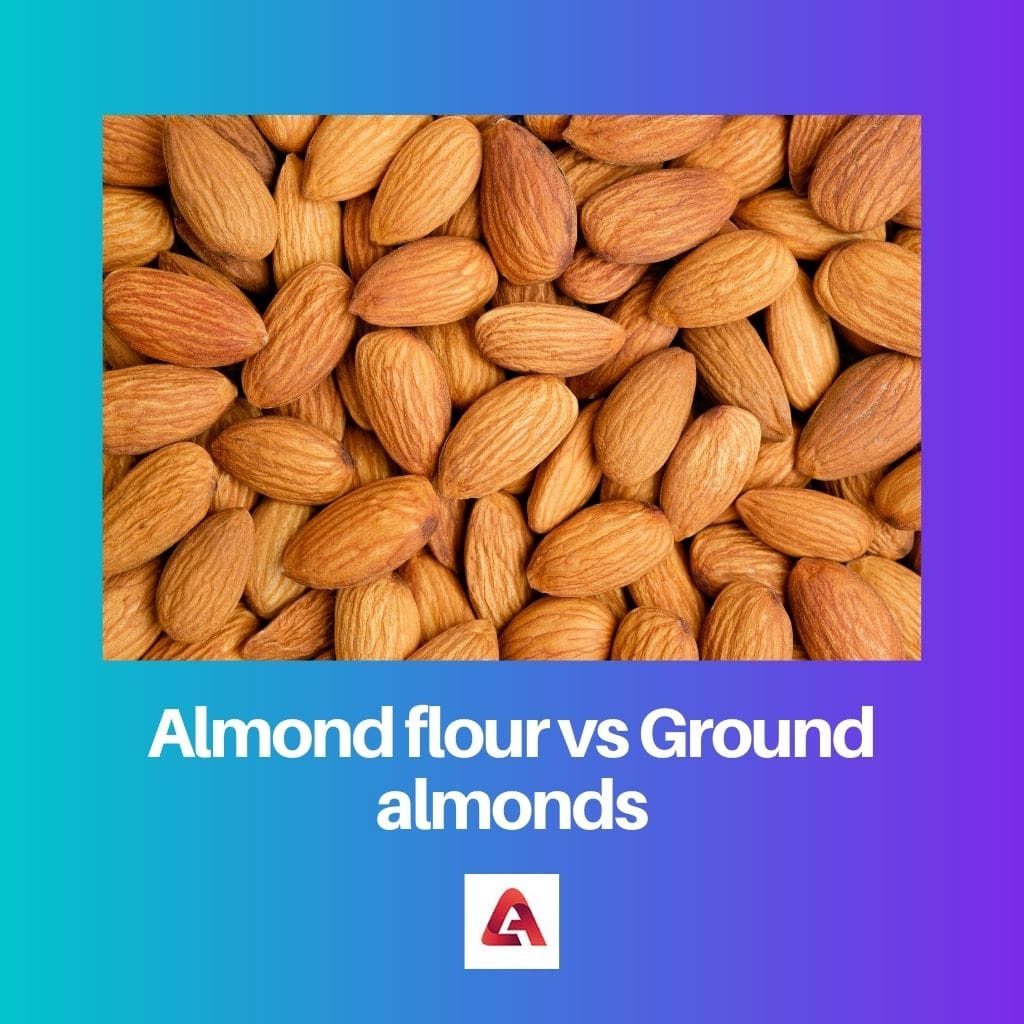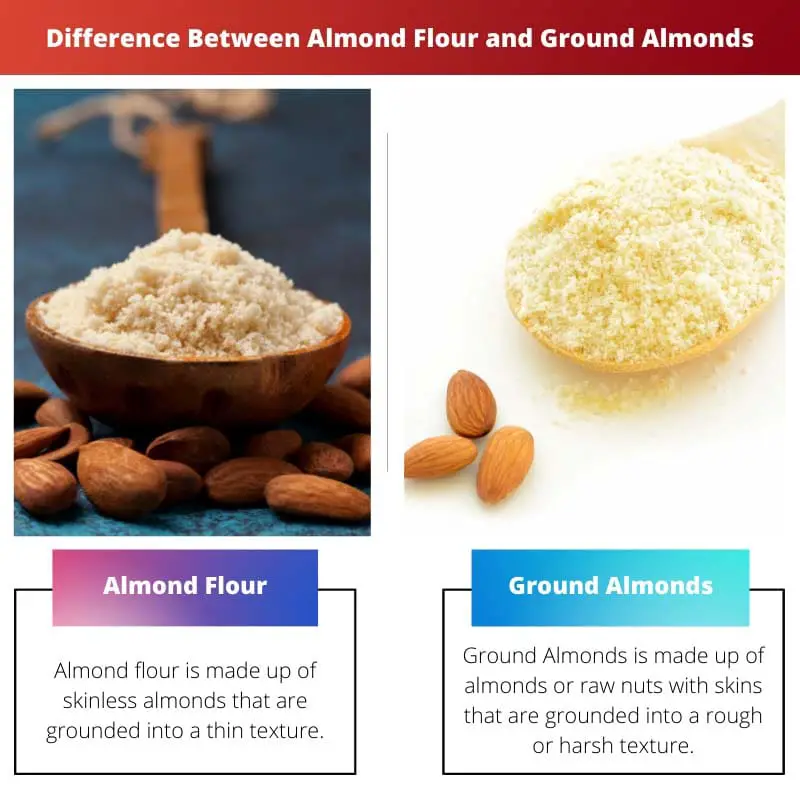Almonds are a type of nut produced and processed in larger quantities and have many nutrients.
Key Takeaways
- Almond flour is made from blanched almonds with the skins removed and finely ground, resulting in a smooth, uniform texture.
- Ground almonds, also known as almond meal, may include the skins and have a coarser texture than almond flour.
- Both almond flour and ground almonds are gluten-free alternatives to wheat flour, but their different textures and nutritional profiles can impact recipes and baked goods.
Almond Flour vs Ground Almonds
The main difference between almond flour and ground almonds is that Almond flour is made up of skinless almonds grounded in a thin texture. In contrast, Ground Almonds, on the other hand, are made up of almonds or raw nuts with skins that are grounded into a rough or harsh texture.

Almond flour is skinless almonds made into a thin texture and stored in cold places. On the other hand, Ground almonds are raw almonds with skin that are ground into a harsh texture and packaged up.
Comparison Table
| Parameter of Comparison | Almond Flour | Ground Almonds |
|---|---|---|
| Made from | Almond flour is made up of skinless almonds that are grounded in a thin texture. | On the other hand, Ground Almonds are made up of almonds or raw nuts with skins that are grounded into a rough or harsh texture. |
| Texture and colour | The texture is very fine and fluffy, and the colour is a light cream colour. | The texture is coarse, i.e. rough or harsh, and the colour is ivory, i.e. dark sandy-like colour. |
| Nutritional content (per 100 grams) | Fat- 14g, Protein- 48 g, Calories- 375cal, Net carbs-20g | Fat- 56g, Protein – 21g, Calories -630cal, Net carbs- 7g |
| Uses | As almond flour has a thin texture, it is best for baking good with fluffier consistencies, for example, for baking cookies, treats, muffins and cakes. | As ground almonds have heavier and rough textures, food items including denser consistency like bread, muffins, wafers or pancakes can be made. |
What is Almond Flour?
The increase in the popularity of almond flour has resulted in replacing standard normal day-use flour. It carries identical nutrients to others as it contains whole almonds.
It provides vitamin B, calcium, iron and vitamin E, which is 40% of the daily requirement for a body. Almond flour is made when the skin of the almond is removed and, when grounded, makes a smooth, thin texture.
It is very light in colour, i.e. light creamy and looks identical to regular flour. Moreover, almond flour is healthy and the best alternative to processed flour as it is good for the heart and soul.
For people who have problems with gluten products, almond flour is a suitable option as it is helpful for gluten-sensitive digestive systems. As it contains fats and proteins, it is best for baking goods with more flavour and moisture, such as bread, muffins, snack bars and cookies.
These food items help in giving you satisfaction and happiness without increasing your weight and minimising snacking. As it is low in carbohydrates, it works best as a healthier alternative to wheat.
| # | Preview | Product | |
|---|---|---|---|
| 1 |

| Blue Diamond Almonds Almond Flour, Gluten Free, Blanched, Finely Sifted, 48 oz | Check Price on Amazon |
| 2 |

| Amazon Fresh, Almond Flour, 16 Ounce | Check Price on Amazon |

What are Ground Almonds?
On the other hand, Ground Almonds are made up of almonds or raw nuts with skins that are grounded into a rough or harsh texture. It is also known as an almond meal and has a grain-like texture.
Since the 13th century, it has been used in various bakeries for baking. Homemade almond meal is produced through ground whole nuts, whereas commercial almond meal is produced through remaining grains when residues of almond oil are used to produce almond essence.
The outcome is a drier grind with a harsh texture, which helps baking macarons. Cushing whole almonds with the help of a food processor/mixer grinder results in ground almonds.
If mixed and crushed more, it takes the form of almond butter, as it naturally contains fats and oils. To store ground almonds for a longer period, i.e. up to three months, they should be kept in an airtight container in the freezer.
| # | Preview | Product | |
|---|---|---|---|
| 1 |

| Pure Original Ingredients Almond Meal (1 lb) Great for Baking & Breads, Ground Almonds | Check Price on Amazon |
| 2 |

| Whitworths Ground Almonds - 150g | Check Price on Amazon |

Main Differences Between Almond Flour and Ground Almonds
- Almond flour is made up of skinless almonds grounded in a thin texture, whereas ground Almonds, on the other hand, are made up of almonds or raw nuts with skins grounded in a rough or harsh texture.
- The texture of almond flour is wonderful and fluffy, and the colour is light cream colour whereas the texture of ground almond is coarse, i.e. rough or harsh, and the colour is ivory, i.e. dark sandy-like colour.
- Nutritional content (per 100 grams) in almond flour is Fat- 14g, Protein- 48 g, calories- 375cal and Net carbs-20g. Nutritional content (per 100 gram) in ground almond Fat- 56g, protein – 21g, calories -630cal and Net carbs- 7g
- As almond flour has a thin texture, it is best for baking good with fluffier consistencies, for instance, cookies, muffins and cakes. In contrast, as ground almonds have heavier and rough textures, food items, including denser consistency like bread, muffins, wafers, or pancakes, can be made.
- If almond flour is required in fine consistency, it Can be brought commercially, whereas Coarse flour can be homemade. Ground almonds can be made homemade from raw materials or Bought readymade.

- https://onlinelibrary.wiley.com/doi/abs/10.1002/ejlt.201200115
- https://www.sciencedirect.com/science/article/pii/S0022474X1500017X

Ground almonds seem to be a bit less appealing in terms of texture compared to almond flour. Almond flour looks like a much better option for baking.
I agree, plus the nutritional content of almond flour is fantastic!
Almond flour’s nutritional value is really impressive, no wonder it’s gaining popularity as a healthier alternative.
And its versatility in recipes is just amazing.
Absolutely, Anthony! It’s becoming a staple in many kitchens.
I had no idea about the different uses of almond flour and ground almonds. Very informative post!
Same here, Emurray! I learned a lot from this.
Almond flour looks like a great option, especially for those with gluten sensitivities. The health benefits are impressive!
Absolutely. It’s a win-win for health and delicious baked goods!
It’s definitely worth trying, Mia. I’ve had great results with it.
Almond flour really is a versatile and healthy option for baking. I’ve been using it a lot lately!
Yes, it’s a fantastic choice for various recipes and diets.
I love how it adds a nutty flavor to baked goods as well!
I appreciate the detailed nutritional comparison of almond flour and ground almonds. Very helpful!
Agreed, Samuel! It’s great to have all this information in one place.
Absolutely, I’ve learned a lot from this article.
Almonds are such an amazing healthy option! Almond flour is definitely a go-to substitute for regular flour!
Absolutely! The rich nutrient content in almond flour is truly impressive.
The comparison table provided is so helpful in understanding the differences between almond flour and ground almonds.
Completely agree, I always look for easy comparisons like this.
Great comparison between almond flour and ground almonds.
I’ve always been hesitant to try almond flour, but after reading this, I might just give it a go!
Definitely worth a try. Plus, it’s a healthier choice.
You won’t regret it, Yvonne! Almond flour is a game changer.